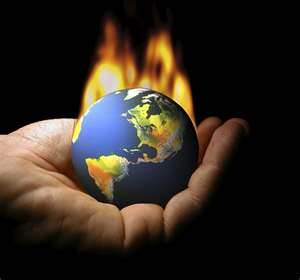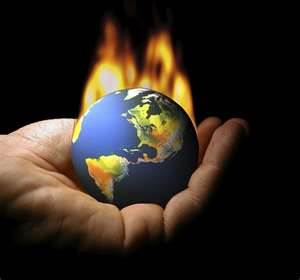 Its coming — its Here .
Its coming — its Here .
AP | By JOAN LOWY .
WASHINGTON (AP) — Wild weather is taking a toll on roads, airports, railways and transit systems across the country.
That’s leaving states and cities searching for ways to brace for more catastrophes like Superstorm Sandy that are straining the nation’s transportation lifelines beyond what their builders imagined.
Despite their concerns about intense rain, historic floods and record heat waves, some transportation planners find it too politically sensitive to say aloud a source of their weather worries: climate change.
Political differences are on the minds of the American Association of State Highway and Transportation Officials, whose advice on the design and maintenance of roads and bridges is closely followed by states. The association recently changed the name of its Climate Change Steering Committee to the less controversial Sustainable Transportation, Energy Infrastructure and Climate Solutions Steering Committee.
Still, there is a recognition that the association’s guidance will need to be updated to reflect the new realities of global warming.
“There is a whole series of standards that are going to have to be revisited in light of the change in climate that is coming at us,” said John Horsley, the association’s executive director.
In the latest and most severe example, Superstorm Sandy inflicted the worst damage to the New York subway system in its 108-year history, halted Amtrak and commuter train service to the city for days, and forced cancellation of thousands of airline flights at airports in New York, New Jersey and Philadelphia.
In Washington state, “we joked we were having 100-year storms every year,” said Paula Hammond, head of the state’s Department of Transportation.
Last year flooding threatened to swallow up the Omaha, Neb., airport, which sits on a bend in the Missouri River. The ground beneath the airfield became saturated, causing about 100 sinkholes and “soil boils” — uplifted areas of earth where water bubbles to the surface. The airport was spared through a massive effort that included installing 70 dewatering wells and stacking sandbags around airport equipment and buildings.
Record-smashing heat from Colorado to Virginia last summer caused train tracks to bend and highway pavement to buckle. A US Airways jet was delayed at Washington’s Reagan National Airport after its wheels got stuck in a soft spot in the tarmac.
Dallas had more than five weeks of consecutive 100 degree-plus high temperatures. “That puts stress on pavements that previously we didn’t see,” Horsley said.
States and cities are trying to come to terms with what the change means to them and how they can prepare for it. Transportation engineers build highways and bridges to last 50 or even 100 years. Now they are reconsidering how to do that, or even whether they can, with so much uncertainty.
No single weather event, even a storm like Sandy, can be ascribed with certainty to climate change, according to scientists. But the increasing severity of extreme events fits with the kind of changing climate conditions that scientists have observed.
For example, several climate scientists say sea level along New York and much of the Northeast is about a foot higher than a century ago, mostly because of man-made global warming, and that added significantly to the damage when Sandy hit.
Making transportation infrastructure more resilient will be expensive, and the bill would come at a particularly difficult time. Aging highways, bridges, trains and buses already are in need of repair or replacement and no longer can handle peak traffic demands. More than 140,000 bridges are structurally deficient or obsolete. The problem only will worsen as the U.S. population grows.
A congressional commission estimated that all levels of government together are spending $138 billion a year less than is needed to maintain the current system and to make modest improvements.
“The infrastructure of the nation is aging and it’s at risk because, quite frankly, we’re all not investing enough to take care of these facilities,” said Hammond, the chairwoman of the climate committee. “And now we’re facing extreme weather threats that cause us to need emergency response capabilities beyond what we’ve had in the past.”
In Washington state, “we have seen more erratic weather patterns that we haven’t had before, so we really can’t imagine what kind of winter or summer we’re going to have anymore,” Hammond said.
More frequent heavy rainfalls in the western half of the state have increased the volume and velocity of water in rivers and streams, undermining the foundations of bridges. Rising sea levels are eroding coastal roads. In the drier eastern half of the state, more frequent wildfires have forced road maintenance crews to change their methods in an effort to prevent sparks that might cause a blaze.
“Each time you replace a bridge, states have to be thinking about not just what kind of traffic demand there is, but how do I make sure this is a bridge that will withstand the future given the erratic weather patterns and climate change we’re seeing,” Hammond said. “It’s a new layer of analysis.”
About half the states have taken some steps toward assessing their most critical vulnerabilities, experts said. But few have gone to the next step of making preparations. New York was an exception. Not only had transit officials made detailed assessments of the potential effects of climate change, but they’d started to put protections in place. Subway entrances and ventilation grates were raised in low-lying areas to reduce flooding, but that effort was overwhelmed by Sandy.
“They got hit with what was even worse than even their worst-case scenario,” said Deron Lovaas, a transportation expert with the Natural Resources Defense Council, an environmental group. “This was an active test of … climate preparedness, and they failed.”
While more than 97 percent of the scientists who publish peer-reviewed research say that global warming is real and man-made, the issue remains highly charged. In conservative states, the term “climate change” is often associated with left-leaning politics.
Planning for weather extremes is hampered by reluctance among many officials to discuss anything labeled “climate change,” Horsley said.
“In the Northeast, you can call it climate change. … That’s an acceptable term in that region of the country,” he said. “Elsewhere, in the South and the (Mountain) West, it’s still not an acceptable term because of ideology or whatever you want to call it.”
For example, Horsley said, in North Dakota, where there has been severe flooding in recent years, state officials avoid bringing up global warming, preferring to couch their discussions on how to shore up infrastructure as flood preparation.
The Obama administration has also shied away from talking publicly about adaptation to climate change. Transportation Secretary Ray LaHood’s office refused to allow any department officials to be interviewed by The Associated Press about the agency’s efforts to help states adapt. The Transportation Department and other federal agencies are involved in preparing a national assessment of climate change impacts and adaptations that may be needed. Their report is expected to be finished in the next few months.
Steve Winkelman, director of transportation and adaptation programs at the Center for Clean Air Policy, said he uses terms like “hazard mitigation” and “emergency preparedness” rather than climate change when talking to state and local officials.
“This is about my basement flooding, not the polar bear — what I call inconvenient sewer overflow,” Winkelman said. “It makes it real.”
 This is our year, 2013, to make our personal contact with some group of interdimensional beings. It’s our year because the earth as we know it is changing rapidly before our eyes and the vast majority doesn’t realize what they see. The future will change in every way. As I have said in past postings the horse is out of the barn with the rest of the animals and the barn just burned to the ground. The bottom line is there is no fixing our climate disaster, we can only prepare.
This is our year, 2013, to make our personal contact with some group of interdimensional beings. It’s our year because the earth as we know it is changing rapidly before our eyes and the vast majority doesn’t realize what they see. The future will change in every way. As I have said in past postings the horse is out of the barn with the rest of the animals and the barn just burned to the ground. The bottom line is there is no fixing our climate disaster, we can only prepare.







